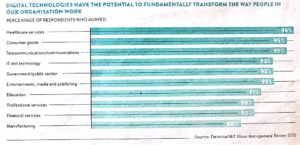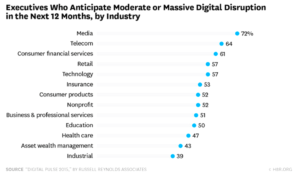
Digitalisation I – What to Consider Beforehand
What to Consider Before Digitalising
Orientation in the Digital Jungle
Digitalisation is one of THE buzzwords of today. The early e-wave hit some industries (music, publishing) decades ago already. Surprisingly enough, the concept of avant-garde technologies enabling companies to break into completely new markets is still something that is not on many executives’ radar. I believe that technological changes to the way you and I will live, work and interact in future can help align our life and work to our human nature. That might sound ironic, even sarcastic, to some of you.
Let me explain what I envision.
Digitalisation can be daunting, but it can also be an engaging journey, transforming your business for the better. There is a lot of confusion about what digitalisation means in general and for specific industries, organisations and professionals.
This mini series offers a business perspective and aims to inform, clarify and provide a shared understanding as well as specific tips for getting your head around digitalisation.
Part One outlines the different concepts and helps you understand where you fit in. The second part looks at the overall organisational impact and why digitalisation is more transformation than change for most. This part will be a series of seven short articles which will look at 7 essential aspects of business [strategy, structure, systems, style, staff, skills, shared values] and how they are being impacted by digitalisation.
The third part takes a closer look at internal digitalisation (aka Industry 4.0) whilst part four tackles external digitalisation and highlights some facts and figures to give us a glimpse into the future.
Let’s start with a definition. To digitise is to convert an object, data or image into electronic format. Digitalisation is the use of digital technologies to change a business model and provide new revenue and value-producing opportunities; it is the process of going digital. Or, in the words of Mike Bracken, former UK government chief data officer: “It means applying the culture, practices, processes and technologies of the internet era to respond to people’s raised expectations.”
What Industry Are You In?
The ongoing digitalisation process has already had its casualties. Most of the traditional telecommunication was and still is not prepared for technological advancements and this new kind of competition. Photography and picture management have changed dramatically over the last 20 years. So we have already seen some impact and the list of companies who fail to engage in this accelerating change is growing.

The sense of urgency will differ whether you are in the B2B or B2C market. The latter had a much earlier and broader interaction with social media. At this very moment, if you want to grab the attention of over 80% of prospective B2C customers, or close to 95% for B2B, you need to go digital. The list of industries where executives anticipate going through a fundamental digital transformation is impressive, isn’t it?

Two Different Kinds of Digitalisation
1. Internal Digital Transformation
Let’s be clear. By digital transformation we are not referring to the implementation of a new digitised, paperless flow or an automated application process. These are natural advancements utilising digitisation solutions to reduce cost, improve quality or increase speed. We believe that digital transformation comes with a clear strategic objective, aligns and coordinates efforts and ambitions. Embedding technologies into daily business activities becomes the very essence of the business strategy, rather than one of its parts.
Heard of Kodak? These guys invested millions into an aggressive marketing campaign with a former Apple consultant on the side and all bases covered. However, their ‘digital brand’ campaign never turned into a digital strategy since they continued working in an ‘analogue’ way. They ended up with major losses because their approach lacked authenticity.
Digitalisation involves and impacts the entire organisation. IT is just one piece of the puzzle and it is ultimately about business culture and how people do business, as well as specific skills.
Read more about impact on the business as a whole in part two of this series.
You are well advised to start your digitalisation internally before venturing into external digitalisation. Streamline your business by improving processes, automating, collecting and understanding data, and focus on your core value chains. Don’t forget about your people. They need development opportunities and empowerment to take on more responsibility. The leadership style required for internal digitalisation is more about management by objectives and constructive feedback, coaching more than instructing.
More details about this in part three.
2. External Digital Transformation
Once you feel confident with internal digitalisation and everyone is on board, you can start your external digital transformation. This is much more complex because it means connecting and exchanging information within your eco-system in order to become an active part of it. It means engaging, collaborating and possibly co-creating with suppliers, partners, clients and even competitors. It is often outside your direct control and is in many ways like starting a journey into the unknown.
The Journey Ahead
As with every journey, it’s essential to have a good map. In the case of digitalisation, it’s an overall transformation strategy that will help build the foundation for business change and growth. Digital transformation should be an integrated part of your business strategy, which must adapt along the way.
Read next about the impact on the organisation and how to systematically involve everyone in the journey into the future. Where else do you want to go?
To see our Pathfinder assessment in action and receive some meaningful feedback, please try our Pathfinder Freemium version.





